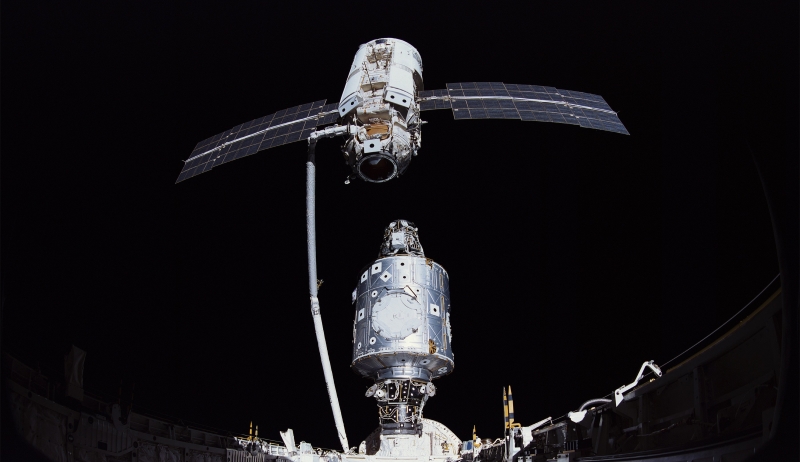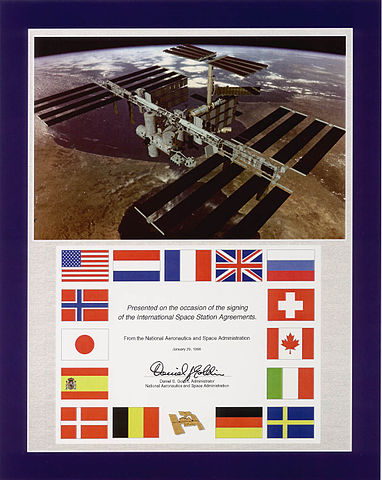Wonderful outpost in orbit
November 20 marks the 20th anniversary of the International Space Station. I have no doubt that there will be a lot of stories about its history, design and operation. I do not want to repeat the same thing, and I decided to reflect on what would be the most important for us from the experience that the ISS gave?

Docking of the first modules of the ISS Zarya and Unity December 6, 1998, photo by NASA
Now every new day of the ISS operation is a record of the duration of operation. The
previous record holder, the Mir station, stayed in orbit for 15 years (5511 days), of which 12.5 were inhabited (4594 days). The ISS is in orbit since November 20, 1998, which is 1.3 times more, and has been continuously inhabited since November 18, 2000, which is one and a half times more. At the same time, the work of the ISS is precisely extended to 2024, and it is quite possible that the station will continue to operate. This is a completely unique experience in operating, aging and repairing technical systems. At the same time, the “old woman” of the ISS is still very cheerfully holding up - there is no noticeable increase in the number and severity of accidents. The longer mankind is going to work in space, the more benefits the ISS experience will bring.

Damage to the heat sink panel S1 in 2008, NASA photo
Construction and operation of the ISS - the most useful and positive experience of international cooperation.

Cover of the ISS Treaty
In the early 90s, work on the ISS looked like a real miracle - people who had recently learned to shoot at each other (this is not an exaggeration, there were quite a few military pilots among cosmonauts and astronauts), began to work together. And Russia with the United States is not limited to the list of participating countries - in fact also Canada, Japan and thirteen countries of the European Space Agency (Brazil was also, but, unfortunately, left the project). This experience is especially useful to remember now, during the next cooling of relations between Russia and the United States. Whatever happens today, we are able to negotiate. And expensive space projects, which are engaged in fundamental science and do not bring instant profit, are best of all built by the whole world.
This also includes the fact that the ISS remained a completely civilian object - the predictions of alarmists about the placement of weapons at the station turned out to be, fortunately, erroneous.
At the ISS, we study how a person will live and work in space.
Even if humanity in the future becomes cyborg, the experience of the ISS will be useful for the functioning of the biological part in space. Weightlessness is not a familiar and harmless environment for people, well-known problems with muscles, bones, eyesight. And even if, in the foreseeable future, artificial gravity generators appear (which is very unlikely), questions of the effects of cosmic radiation or psychological aspects of working in space will not disappear.
ISS - a lot of science
in twenty years at the station heldmore than 1500 experiments. And the directions of research were very different - from dusty plasma and Bose-Einstein condensate to the spread of the flame and the reproduction of living organisms.

Jellyfish from flames in zero gravity on the ISS. The
ISS shows how interesting and cool the

Halloween space is on the ISS.
Popularization and PR activities on the ISS cover various segments of the audience. Junior schoolchildren can be shown the classic experiments with water in zero gravity, senior pupils and students - serious and beautiful experiments. Even those who skipped school, it will be clear that chasing colleagues in a gorilla costume, singing with a guitaror arrange a costume party, which will smile all the Internet - it's cool.
The ISS demonstrates that we still have a lot to learn in order to go to Mars.
The crew of three people consumes about 7 tons of supplies per semi-annual watch, with the vast majority of them being used and thrown away. Some more tons are spent on spare parts. And if such a scheme works for the near-Earth orbit, then for long flights far from Earth, where it is not possible to replace the warehouse from a warehouse in case of a breakdown and bring a new backup device to the nearest cargo ship, only one “extra” accident can put the entire mission on the brink of disaster. Right now, in relatively comfortable and safe conditions, we must train to work withclosed life support systems and to repair broken in place.
ISS is still early to retire
Initially, the ISS set goals to be a laboratory, an observatory and a plant in orbit. In 2010, added commercial, diplomatic and educational purposes. Also, mission servicing beyond the limits of the Earth’s orbit was called possible. And if everything is fine with the laboratory, the observatory and the classroom, the remaining tasks have not been properly accomplished yet. Weightlessness is a special physical condition that cannot be obtained on Earth for a long time. It is worth trying to experiment with growing proteins or crystals - what if it shoots? Commercial use of the station also has room to grow - there have been no tourists on the ISS for a long time. So, despite the fact that for technology 20 years is a long time, the international space station can still bring a lot of benefit. Happy Birthday, ISS!

Docking of the first modules of the ISS Zarya and Unity December 6, 1998, photo by NASA
Now every new day of the ISS operation is a record of the duration of operation. The
previous record holder, the Mir station, stayed in orbit for 15 years (5511 days), of which 12.5 were inhabited (4594 days). The ISS is in orbit since November 20, 1998, which is 1.3 times more, and has been continuously inhabited since November 18, 2000, which is one and a half times more. At the same time, the work of the ISS is precisely extended to 2024, and it is quite possible that the station will continue to operate. This is a completely unique experience in operating, aging and repairing technical systems. At the same time, the “old woman” of the ISS is still very cheerfully holding up - there is no noticeable increase in the number and severity of accidents. The longer mankind is going to work in space, the more benefits the ISS experience will bring.

Damage to the heat sink panel S1 in 2008, NASA photo
Construction and operation of the ISS - the most useful and positive experience of international cooperation.

Cover of the ISS Treaty
In the early 90s, work on the ISS looked like a real miracle - people who had recently learned to shoot at each other (this is not an exaggeration, there were quite a few military pilots among cosmonauts and astronauts), began to work together. And Russia with the United States is not limited to the list of participating countries - in fact also Canada, Japan and thirteen countries of the European Space Agency (Brazil was also, but, unfortunately, left the project). This experience is especially useful to remember now, during the next cooling of relations between Russia and the United States. Whatever happens today, we are able to negotiate. And expensive space projects, which are engaged in fundamental science and do not bring instant profit, are best of all built by the whole world.
This also includes the fact that the ISS remained a completely civilian object - the predictions of alarmists about the placement of weapons at the station turned out to be, fortunately, erroneous.
At the ISS, we study how a person will live and work in space.
Even if humanity in the future becomes cyborg, the experience of the ISS will be useful for the functioning of the biological part in space. Weightlessness is not a familiar and harmless environment for people, well-known problems with muscles, bones, eyesight. And even if, in the foreseeable future, artificial gravity generators appear (which is very unlikely), questions of the effects of cosmic radiation or psychological aspects of working in space will not disappear.
ISS - a lot of science
in twenty years at the station heldmore than 1500 experiments. And the directions of research were very different - from dusty plasma and Bose-Einstein condensate to the spread of the flame and the reproduction of living organisms.

Jellyfish from flames in zero gravity on the ISS. The
ISS shows how interesting and cool the

Halloween space is on the ISS.
Popularization and PR activities on the ISS cover various segments of the audience. Junior schoolchildren can be shown the classic experiments with water in zero gravity, senior pupils and students - serious and beautiful experiments. Even those who skipped school, it will be clear that chasing colleagues in a gorilla costume, singing with a guitaror arrange a costume party, which will smile all the Internet - it's cool.
The ISS demonstrates that we still have a lot to learn in order to go to Mars.
The crew of three people consumes about 7 tons of supplies per semi-annual watch, with the vast majority of them being used and thrown away. Some more tons are spent on spare parts. And if such a scheme works for the near-Earth orbit, then for long flights far from Earth, where it is not possible to replace the warehouse from a warehouse in case of a breakdown and bring a new backup device to the nearest cargo ship, only one “extra” accident can put the entire mission on the brink of disaster. Right now, in relatively comfortable and safe conditions, we must train to work withclosed life support systems and to repair broken in place.
ISS is still early to retire
Initially, the ISS set goals to be a laboratory, an observatory and a plant in orbit. In 2010, added commercial, diplomatic and educational purposes. Also, mission servicing beyond the limits of the Earth’s orbit was called possible. And if everything is fine with the laboratory, the observatory and the classroom, the remaining tasks have not been properly accomplished yet. Weightlessness is a special physical condition that cannot be obtained on Earth for a long time. It is worth trying to experiment with growing proteins or crystals - what if it shoots? Commercial use of the station also has room to grow - there have been no tourists on the ISS for a long time. So, despite the fact that for technology 20 years is a long time, the international space station can still bring a lot of benefit. Happy Birthday, ISS!
